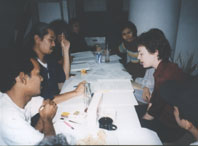
MAJOR ACTIVITIES
Media Program | Youth and sport | Visual and performing arts and arts heritage | Professions and science and technology | Indonesian language and culture studies | Australian culture and English language studies | Civil Society Program
VISUAL AND PERFORMING ARTS AND ARTS HERITAGE
The Institute aims to cultivate in Indonesia and Australia an appreciation of the quality, diversity and sophistication of the visual and performing arts in the two countries; and to develop a market in Indonesia for Australian visual and performing arts and Australian expertise.
Key highlights of visual and performing arts: 1998-99
Two highlights of the Institute's 1998-99 arts program and initiatives were the exhibitions Indonesian Gold: Treasures from the National Museum, Jakarta in Australia and Richness in Diversity in Jakarta.
|
Indonesian Gold: During 1999 the Institute joined with the Queensland government and Thiess International as primary sponsors of the exhibition Indonesian Gold: Treasures from the National Museum, Jakarta, displayed at the Queensland Art Gallery and the Art Gallery of NSW. The |
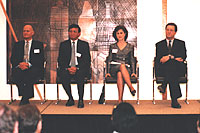
Launch of Indonesian Gold: Treasures from the National Museum, Jakarta at the Queensland Art Gallery, 25 March 1999. Left to right: Mr Michael Darling, Chief Executive Art Exhibitions Australia; His Excellency Mr S Wiryono, Ambassador for Indonesia; Lady Edwards, Chairperson Queensland Art Gallery Board; the Minister for Foreign Affairs, Mr Downer. (Photograph Mike Curtain) |
Richness in Diversity: The AII joined with the Department of Foreign Affairs and Trade and the Australia Council to part-fund Richness in Diversity, a showcase of Australian culture, which opened in Jakarta on 15 April 1999. The exhibition promoted positive images of Australia as a diverse nation highlighting the economic and social benefits that cultural diversity brings. The exhibition was opened in Sydney in October 1998 by the Prime Minister, Mr Howard, who thanked the Institute for being the exhibition's principal sponsor. The exhibition travelled to Indonesia, Malaysia, Singapore, Korea, Thailand, China, Japan and the Philippines. Richness in Diversity was a dynamic exhibition with a high video and pictorial content. All signage was in the language of the host country and visitors were able to use interactive terminals on a wide range of general Australian subjects. It ran from 15 April to 9 May 1999 at the Plaza Atrium shopping mall in Jakarta.
Other highlights of visual and performing arts: 1996-99
The Institute's visual and performing arts programs and initiatives in Indonesia and Australia during the period 1996-99 provide a diverse range of activities. Some small exhibitions and performances were held at the Australian Embassy, some with significant corporate sponsorship. Some highlights of visual and performing arts are listed below.
Performing artsSarah Hopkins: An Indonesian tour by Australian musician Sarah Hopkins (15-26 April 1996), part-funded by the Institute, was highly successful in terms of audience acceptance and cost effectiveness. Hopkins, whose 'visionary music' involves cello and harmonic overtone singing, performed for capacity audiences in Medan, Jakarta (the Forum Music Festival at Taman Ismail Marzuki - TIM), Ujung Pandang and Denpasar. Alan Dargin: Performances by Alan Dargin, the noted didgeridoo player, received extensive publicity when the AII arranged for him to visit Indonesia for the official launch of Sydney 2000 at the Jakarta Embassy on 19 August 1996. |
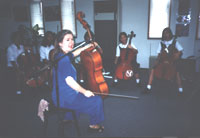
Australian musician Ms Sarah Hopkins with students at the Pelita Harapan School in Jakarta, April 1996. |
Kinetic Theatre Company: From 7 to 28 October 1996 the Kinetic Energy Theatre Company (Graham Jones and Jepke Goudsmit) gave a series of drama workshops and performances, which targeted performing arts students at three major institutions. These were the Jakarta Institute of Arts (Institute Kesenian Jakarta - IKJ), the Indonesian Institute of Arts (Institut Seni Indonesia -ISI) in Yogyakarta and at Medan's Christian (HKPB) Nommensen University.
Bangarra Dance Theatre: In terms of national print and electronic media publicity and overall impact, the best outcome for 1996 was achieved with performances in Jakarta on 4 and 5 October 1996 by the Bangarra Dance Theatre. Travelling under the joint sponsorship of the Institute, the Australia Council and the NSW Ministry of the Arts, Bangarra performed their work Ochres at the Graha Bhakti Budaya theatre at Taman Ismail Marzuki-(TIM).
Mike Nock Jazz Quartet: The Sydney-based Mike Nock Jazz Quartet toured Indonesia (Jakarta, Bandung and Yogyakarta) from 22 June to 6 July 1996 as part of its first South East Asian tour. Mike Nock proved a hit with patrons of Indonesia's leading jazz venue, JAMZ, where the group performed for three nights. The group also conducted workshops for advanced students in Jakarta and performed at the Indonesian Institute of the Arts (ISI) in Yogyakarta. Feedback was very positive, including an offer from JAMZ to return on a commercial basis.
Trio Madois: Sydney-based musician Margaret Bradley, and two leading Sundanese musicians came together as Trio Madois in January 1997 to perform traditional Sundanese pieces of music, as well as Bradley's own compositions in the Sundanese style. The Institute funded a tour by Trio Madois who performed at Sangatta in West Kalimantan, Medan and Jakarta, winning extensive reviews in the national press.
Australian drama: In March 1997 the Institute sponsored the production in Indonesia of two short plays by Jack Hibberd. A Jakarta drama group, Teater Kami, performed the plays for a three-night season to packed houses in the Jakarta embassy theatre. In April 1999 the Institute sponsored a Teater Kami production of another Hibberd play, The Overcoat, which was presented in Jakarta and Bandung. The Institute provided funds for Hibberd to attend the Jakarta production. In 1998 and 1999, the Institute also sponsored productions by an expatriate group, The Jakarta Players, of plays in English by Australian playwrights David Williamson and Louis Nowra.
Pot Pourri: The Melbourne-based cabaret group Pot Pourri, part of Australian Music Theatre, first performed in Jakarta in November 1996 in a tour sponsored jointly by the Institute and the British International School in Jakarta. Pot Pourri was very well received and made a return visit to Jakarta under the auspices of the Institute, the Australia-New Zealand Association (ANZA) and the Jakarta Regent to perform at a 'Cabaret Brunch' at the Regent Hotel on Sunday 31 May 1998.
Takacross: The Institute provided logistical and some financial support for the Sydney percussion group Takacross, which drew big crowds when it performed at the Jakarta Festival (JAKFEST) in July 1997.
Geoffrey Saba: The Australian pianist Geoffrey Saba, who has developed a following in Indonesia, performed at the Australian Embassy in October 1997 and again in September 1999.
Visual arts
Scott Gilbank: In July and August 1996 the Institute funded an exhibition in the Taman Budaya (Art Centre) in Mataram, Lombok, of photographs of Australian outback landscapes by Jakarta-based photographer Scott Gilbank. The exhibition was well received and similar exhibitions of Gilbank's work were arranged in Padang (April 1997) and Medan (April 1998), the latter coinciding with the opening of the Australia Centre and the Austrade regional office.
Jerry T: Indonesian artist Jerry T exhibited his paintings and sketches of Australian scenes in the embassy gallery in Jakarta in August 1996. It was the first time an Indonesian artist had exhibited in the Embassy and the public response was very positive. There was good publicity and about a third of the works were sold. Jerry T's second exhibition, of Australian landscapes in the Embassy in April 1999, was a sell-out.
Helpmann Academy: A small exhibition of jewellery entitled Triptych was mounted in Jakarta and Bandung in September 1996 under the auspices of the Institute and the Adelaide-based Helpmann Academy. The exhibition consisted of some 40 works by teachers, students and graduates of the constituent universities and colleges that come under the umbrella of the Helpmann Academy.
Architecture: A pictorial exhibition of Australian house designs was staged by the Institute at the Jakarta Embassy in February 1997. The exhibition, entitled House Styles, which consisted entirely of photographs of houses designed by graduates, staff and students of the Architecture Faculty of the University of Queensland, received good publicity, which led to it being mounted at short notice at the Bandung Institute of Technology.
Dreampower: On 1 June 1997 an exhibition entitled Dreampower: Art of Contemporary Aboriginal Australia opened at the Museum Puri Lukisan, Ubud, for a one-month showing. The exhibition then moved on to Yogyakarta and wound up with a two-week showing in Jakarta at the national art gallery (Gedung Pameran Seni Rupa) where it was officially opened on 4 August by the then Minister for Education and Culture, Wardiman Djojonegoro. Dreampower, the first major exhibition in Indonesia of contemporary Aboriginal art, was a collection of canvases and batik works on silk by 13 artists, mainly from the Utopia Downs School. The exhibition's Indonesian tour was facilitated by the Institute and curated and funded by the owner of an independent gallery (David Cossey, Gallerie Australis, Adelaide). The touring exhibition was non-commercial and, from the Institute's point of view, represented excellent value as a high-impact but low-cost exercise.
Kate Regnault: A young Australian artist and 1997 ANU fine arts graduate, Kate Regnault, exhibited at the Jakarta Embassy with Institute support in January 1998. Her works showed a marked Indonesian influence and about half were sold.
Australian pictorial design: In conjunction with Austrade the Institute arranged an exhibition of pictorial design by David and Cherie Miles of Miles Design Pty Ltd, Sydney. It was the first time Australian pictorial design, as opposed to fine art, had been exhibited in Indonesia.
Patterning: Patterning - Layers of Meaning, an Australian exhibition which explored the use of traditional patterning in contemporary art and crafts, toured Yogyakarta, Ubud, Bandung and Jakarta with great success during May-August 1998. Curated and toured under the auspices of Asialink with Institute funding, Patterning was curated by Merryn Gates of the Canberra School of Art to showcase the work of 10 Australian individuals and groups. The exhibition promoted Australian contemporary art with a distinctly multicultural flavour, focusing on its diversity and technical sophistication. In tandem with Patterning, an Indonesian exhibition curated by Jim Supangkat, Signifying Decorativeness - Layers of Meaning, featured leading Indonesian contemporary artists and added considerable value to the Patterning project by drawing large crowds to the exhibitions.
Wayang Listrik and Trepang: The Institute contributed to the travel and associated costs to bring the 50-member Wayang Listrik - Electric Puppet Theatre (later Campur Campuran) from Bali to perform at the Festival of Darwin in 1998. The program provided an important opportunity for Australians and Indonesians to work together in a creative medium that allowed artists from both cultures to be innovative and to develop new audiences. The Institute also funded the Sulawesi-based performing group, Trepang, for the Festival of Darwin in 1999.
Ceramic art and pottery in Bali: Commencing in 1998 the Institute funded Brian Alexander for a three-year program to improve the quality of ceramic art and pottery and the productivity of ceramic artists in Bali. The project included research, design, tuition, writing of technical material translated into Bahasa Indonesia, and the introduction of English terminology to enable a better understanding of English technical publications in ceramic art and pottery.
Security fears and economic crisis - effect on cultural programs: Several Institute visual and performing arts programs in Indonesia were disrupted from mid-1996 onward by the security situation in Indonesia. Following the 26 July 1996 anti-government riots, for example, the Asmat Foundation decided, for security reasons, not to proceed with its high-profile sponsorship and organisation of a visit by the West Australian Ballet, scheduled for August 1996. In mid-1998 the economic crisis and the May riots in Jakarta were given as the reasons for the cancellation of two large events - the Jakarta Festival and the Borobudur Festival (dance and folk music) - to which Australian artists had committed.
ARTS HERITAGE
AusHeritage: Recognising the importance of assisting Indonesia with its efforts to preserve its arts heritage, and to help build the capacity to continue the process, the Institute focused on a program of arts heritage. Australia is regarded as one of the leaders in heritage management and conservation. It has a sound reputation in heritage legislation and policy, in heritage theory, methodologies, research, processes, exhibitions and publications. AusHeritage is a national network of Australian heritage industry practitioners whose purpose is to work with colleagues and clients in the international cultural heritage area, on a commercial or cooperative basis.
During 1999 the Institute and AusHeritage developed a strategic relationship through the exchange of information relating to cultural heritage matters in Indonesia. Since its establishment AusHeritage has enjoyed a close engagement with Indonesia, culminating in the signing in May 1999 of a Memorandum of Understanding (MOU) with the Ministry of Education and Culture, Jakarta. The MOU covers the areas of preservation and conservation of buildings and artefacts, museum practice and management, and the arts, including management and conservation of the post-Independence national art collection. The MOU will be in force for three years in the first instance, and offers opportunities for many Australians and Indonesians to work cooperatively on a wide range and scale of projects across the archipelago. AusHeritage has major programs in Sumatra, Java and Bali and is working in partnership with the Association of South East Asian Nations Committee on Culture and Information.
Yogyakarta: The Institute assisted AusHeritage to work with members of the Yogyakarta Heritage Society (YHS) on a cooperative management program for the conservation of the walled historic city in central Yogyakarta. The old walled city is one of seven declared historical districts, and contains the famous fortified Keraton and the Tamansari water gardens.
Fine arts scholarships: The Institute has funded two fine arts graduates, one from Gadjah Mada University, Yogyakarta, and one from the Institute of Technology, Bandung, to study paintings conservation at Artlab, Adelaide, in 1999. The project included return visits of Artlab conservators to Indonesia to present workshops with the two Indonesian conservators in Jakarta and further afield. The project included a 'train the trainers' component, in which Artlab conservators presented 'preventative conservation' workshops in Indonesia.
Gamelan Digul: During 1998 and 1999 the Institute funded a project for the repair, tuning, conservation and exhibition of a complete gamelan consisting of 21 musical instruments of a traditional orchestra of Central Java. This Gamelan Digul was made more than 70 years ago in a Dutch prison camp in Irian Jaya and brought to Australia during World War II through events that link Australian and Indonesian people. The project included the writing and publishing of a book by Professor Margaret Kartomi of the Music Department at Monash University.
ARTS RESIDENCIES
Maintaining a tradition established in 1993, the Institute supported residency programs for visual and performing artists and a writer through Asialink. The program was expanded to include an arts management residency in 1997-98 and 1998-99. The residency programs continued to provide a valuable opportunity for Australians to collaborate in an exchange of ideas, skills and knowledge with key Indonesian institutions in their fields of excellence. The residency program enlarged the experience available to Australian artists in Indonesia and enabled a longer-term involvement with Indonesia. Grant recipients were involved in an extensive program of activities during their residencies, including workshops, collaborative exhibitions and performances by the artists. The profile of Australia as a sophisticated, contemporary culture was emphasised through the residencies and media coverage of some residencies was substantial, highlighting Australia as an involved, interested and culturally aware regional partner.
Residency programs undertaken between 1995 and 1999 were as follows:
|
1995-96 1996-97 1997-98 1998-99 1999-2000 |
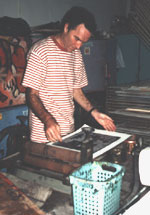
Asialink artist-in-residence, Dr Adam Rish, in the print room at Institut Kesenian Jakarta, 1997. |
|
Some residencies developed on-going contacts that led to further projects involving Australia and Indonesia and provided information to the Australian community about contemporary cultural issues in Indonesia. Adelaide-based ceramics artist Mr Damon Moon undertook a successful residency in visual arts in 1997-98. Some of Mr Moon's work was represented in the Patterning exhibition (May-August 1998). Mr Moon returned to Indonesia as a curator of AWAS! Recent Art from Indonesia, a major international touring exhibition planned for 1999-2000. Other particularly successful arts outcomes have resulted from the residencies of Dr Adam Rish, visual artist (1996-97); Ms Amanda Johnson, visual artist (1997-98); poet/playwright Mr Javant Biarujia as writer-in-residence at the Universitas Indonesia and Petra Christian University from September to December 1998; and novelist Ms Clare Mendes at the Australian Studies Centre, Universitas Indonesia Jakarta. Ms Christine Clark's 1998 residency demonstrated Australia's advanced arts management and curatorship skills. The residency achieved collaboration in this area through sustained contact with a representative group of management and curatorial staff from private and government-run galleries at the Bandung Institute of Technology. Ms Clark, a Project Officer with the Queensland Art Gallery, transferred her knowledge and skills through lectures and workshops. |
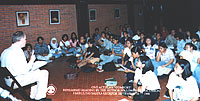
Poet and playwright Mr Javant Biarujia, Asialink artist-in-residence at Universitas Indonesia and Petra Christian University September-December 1998, rehearsing with students.
Ms Christine Clark (right) from the Asialink Arts Management Residency program working with a team in preparation of the Arts Management Workshop, 15-18 March 1999. |
